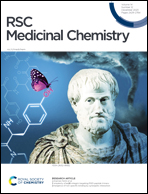Discovery of novel tubulin CBSI (R)-9k from the indanone scaffold for the treatment of colorectal cancer†
Abstract
In view of the serious adverse reactions and clinical toxicity of first line therapy 5-fluorouracil and lack of small molecule therapeutics in colorectal cancer chemotherapy, a series of natural scaffold-based 3-arylindanone derivatives (9a–q) were designed, synthesized and evaluated as tubulin polymerization inhibitors targeting the colchicine site. The most potent colchicine binding site inhibitor (CBSI), (R)-9k, exhibited 14–38 times more dominant anti-proliferative activity against three colon cancer cell lines than 5-fluorouracil. Particularly, (R)-9k showed higher selectivity against human normal cells compared with 5-fluorouracil and colchicine, and displayed negligible cardiotoxicity through hERG assessment. Furthermore, the binding of (R)-9k to the colchicine site was strongly supported by EBI competition assay and (R)-9k inhibited more tubulin polymerization than colchicine. Besides, the mechanism of action and binding modes of (R)-9k were verified by molecular dynamics simulations and docking. Therefore, (R)-9k could be regarded as a promising CBSI for colorectal cancer therapy.



 Please wait while we load your content...
Please wait while we load your content...